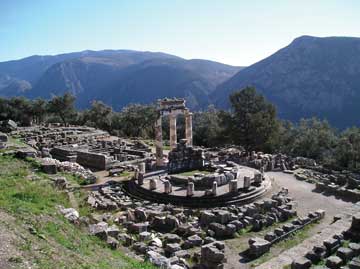|
News Notes
Geoarchaeology
New explanation offered for Delphi trances
 Several millennia ago, young women in hallucinogenic trances provided prophesies and advice from the gods to visitors to a temple in the mountains near Delphi in Greece. Recent research has suggested that these oracles were high on hydrocarbon gases that were leaking out of a series of springs and geologic faults that ran under the temple and throughout the region. A new study discovered that the gas leakage still exists today, but is offering a slightly different explanation for the trances: oxygen deprivation.
Several millennia ago, young women in hallucinogenic trances provided prophesies and advice from the gods to visitors to a temple in the mountains near Delphi in Greece. Recent research has suggested that these oracles were high on hydrocarbon gases that were leaking out of a series of springs and geologic faults that ran under the temple and throughout the region. A new study discovered that the gas leakage still exists today, but is offering a slightly different explanation for the trances: oxygen deprivation.
Researchers recently sampled the carbonate rock around the spring near the Grecian temple at Delphi to determine the types of gas that might be present at the site. Gases are thought to be responsible for the oracle at Delphi’s prophetic powers. Photograph is courtesy of John Sie Yuen Lee.
The previous work had suggested that ethylene, a sweet-smelling hydrocarbon gas, was providing the euphoric mind-altering effects ascribed to the oracles (see Geotimes, May 2002). Researchers, including Jelle de Boer, a geologist at Wesleyan University in Connecticut, had found small amounts of ethylene in the spring waters beneath the temple at Delphi.
But new geochemical analyses indicate that the limestone rocks beneath Delphi could not have produced ethylene, says Giuseppe Etiope, a geologist at the National Institute of Geophysics and Volcanology in Rome, Italy. The ethylene that de Boer and colleagues had measured was instead likely caused by bacterial activity on plants in the springs, Etiope says. They did find other gases emanating from the springs and the soil below the temple, however, including methane and carbon dioxide. In fact, methane is actively exhaled from the soil, and the team found evidence that this activity was much higher in the past.
Based on this evidence, Etiope and his colleagues have hypothesized that the mixing of burned essential oils or perfumes with high volumes of methane and carbon dioxide in an enclosed room in the temple could have created a low-oxygen environment that may have induced the hallucinations. The sweet smells noted in the temple could be either the oils or perfumes, he says, or “theoretically,” it could be benzene (another hydrocarbon gas that is sweet-smelling) dissolved in the springs. The team has not tested for benzene in the area yet, he says, but the geology is right for benzene formation, so it is a “plausible geological explanation” for the sweet scents.
De Boer says, however, that benzene is too strong a gas to have been repeatedly inhaled. Additionally, “the idea of oxygen deprivation is far-fetched,” he says. “None of the Greek and Roman writers, who described the [prophetic] services at Delphi, suggest something like that happened.”
De Boer’s team still thinks that the sweet scents and hallucinogenic effects at Delphi were due to ethylene. He says that Etiope’s team did not find ethylene because the volume of ethylene in the spring water is far lower today than it was centuries ago, and, as ethylene is highly volatile, how much (if any) gas is present depends on whether the water flow is high or low at the time at which a sample is collected.
Still, de Boer says, “research should be continued, especially with more sensitive instrumentation.” Etiope’s paper, published in the October Geology, provides a good example of how further work has brought support and more data for the presence of gases at the site, de Boer says — confirming ancient writers’ descriptions of the oracles’ gas-induced trances.
Megan Sever
Links:
"Ancients right about Delphi," Geotimes, May 2002

 Subscribe
Subscribe

